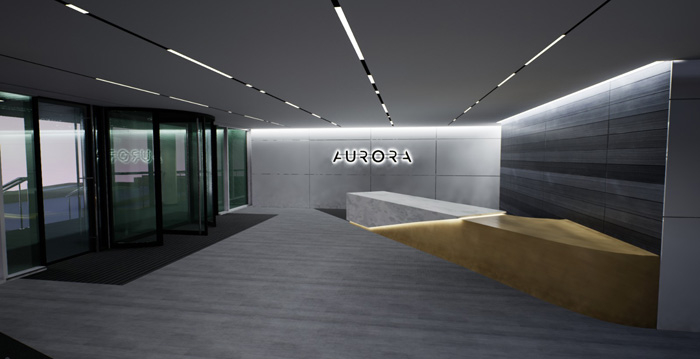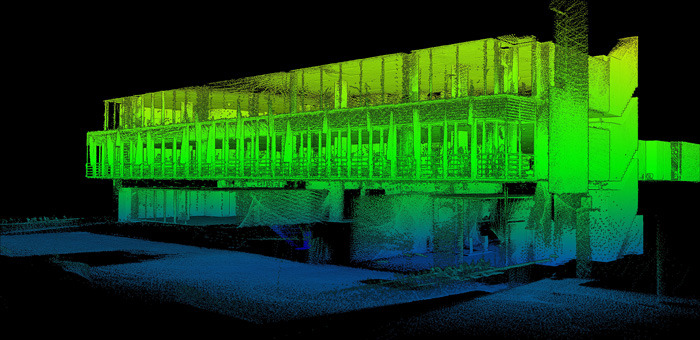The collaborative efforts of a UK real estate advisor and a Parisian BIM supplier developed a digital twin for Aurora, a 4,830 sqm office building in Ealing for one London client, the Moorfield Group
For many high-value, commercial property redevelopments, the client’s expectations are to have the chance to visualise and ‘experience’ the asset before work has even begun onsite. These often take the form of beautiful and captivating ‘artist’s impressions’ or ‘fly-throughs’ – which no doubt catch the eye, but are often lacking accuracy or specific details.
Conversely, the client also needs the hard facts – room & facility specifications & net floor areas to allow for occupancy calculations, fire procedures, rent calculations and an endless array of other requirements. These often take the form of rather less glamorous 2D drawings or spreadsheets.
But what if the client could have both, all in one model? That was the desire of London-based commercial property advisor GVA, as Rupert Parker, Head of Futureproofing, explains, “In the burgeoning London commercial property market, our clients are increasingly demanding technology-driven results. Gone are the days when a 2D floorplan and a few site photos would suffice. On multimillion pound property developments, our clients need to know how the end deliverable will look, feel and operate. Thus, we are increasingly turning to technology such as VR, AR and BIM to deliver these results.”
A French affair
A chance encounter in the summer of 2017 with Joël Lucas of Paris-based BIM Strategies at the TechXLR8 event in London introduced Rupert to a brand-new form of building documentation. BIM Strategies has been utilising mobile mapping technology alongside digital BIM since 2014. The company was involved in a competitive tender commissioned by Paris City Council in 2016 to compare data collection methodologies in a rather unusual location – the Parisian sewer network. The task was to quickly and accurately collect 3D geospatial data along a 1.2km section of the network, and, compare the results to an asset information system from the 1990s.
After three days of intense testing in the complex, cramped environment, the handheld ZEB-REVO scanner from GeoSLAM was considered the best tool for the job. The 3D data from the sewers was used as the source material for BIM Strategies to build a fully-interactive, ‘digital twin’ of the sewer network – providing invaluable asset information to the city authorities for future-proofing the ageing infrastructure.
Rupert immediately saw the potential for this technology in the commercial real estate industry and invited Joël and his team to become ‘Entrepreneurs in Residence’ (EiR) at GVA, as Rupert explains, “The aim of the EiR programme was for both parties to benefit from each other’s expertise and to seek new business opportunities. Having worked alongside each other for a few weeks, the potential uses of what Joël was creating started to flood in.”
A capital idea
The team didn’t have long to wait to test one of these potential uses on a live site. An existing client of GVA, the Moorfield Group, had recently finished the extensive contemporary refurbishment of an office building in Ealing, west London, and were looking to market the property.
The five-storey Aurora building was considered a prime candidate for scanning and creating a digital twin, as refurbishment had just been completed and the property was vacant. The team got to work in the autumn of 2017.
Firstly, the building was surveyed with the ZEB-REVO scanner. Collecting over 40,000 data points per second and with a simple ‘walk and scan’ methodology, the almost 5,000m2 property was scanned in less than two hours. It took another two hours to collect the thousands of digital images which were desired to add texture and context to compliment the 3D data. In less than ½ a day on site, all the required information had been obtained.

The digitisation of real estate
The geospatial data was fed into Autodesk Maya to build the 3D model – and was then ‘textured’ in Unreal Engine – an application more familiar to computer games designers than BIM modellers. The result was an interactive, first-person experience of the asset which could be viewed as a computer animation to prospective tenants – no matter where they were in the world.
But it was also so much more. As well as showcasing a modern property in an engaging and memorable way, the digital twin also holds a wealth of data on the built asset, as Joël Lucas explains, “Now we have a first-person walkthrough experience, and the centimetre-grade accurate survey data in one model. Furthermore, we have enabled the future addition of other practical functionalities – including internet of things (IoT), CCTV, sensors, emergency escape plans and so on. For me, this is the new BIM – all information, all held in one easy to access place.”
Rupert Parker agrees that the power of this offering lies in the wealth of opportunities that it presents, in order to meet the diverse requirements of his client base, “The model is a blank canvas which can be seen as the basis for digitisation of real estate. Working together, BIM Strategies and GVA can develop the model for any clients’ desired use. I am most excited by the prospect of visualising the twin in a ‘live’ capacity through monitoring of human movement and vitals – creating an element of understanding of human interaction with environments never before seen in real estate.”
The success of the pilot scheme has garnered a lot of interest in the London property market – especially the ability to create glamorous and lifelike walk-throughs in as-yet unrenovated properties. The successful collaboration, a result of a chance encounter, seems likely to flourish – and the team are not afraid to think big. “The augmented digital twin is the first step,” said Joël Lucas. “Future offerings will include services for entertainment, marketing, building management, asset management, safety & security – there is no limit!”
■ geoslam.com ■ bim-strategies.com
If you enjoyed this article, subscribe to AEC Magazine for FREE






